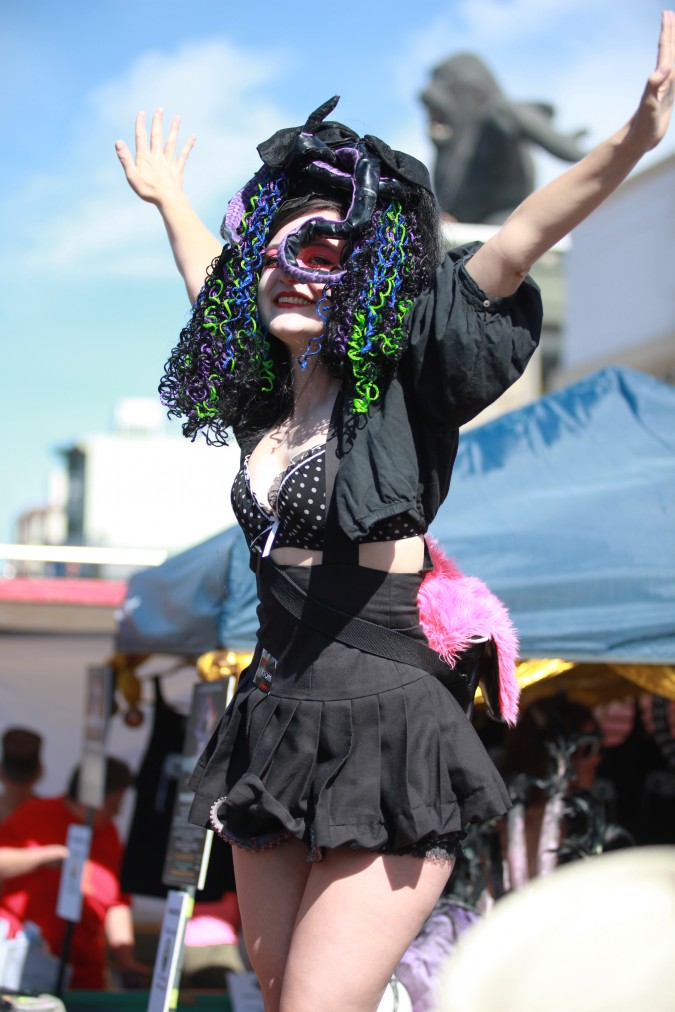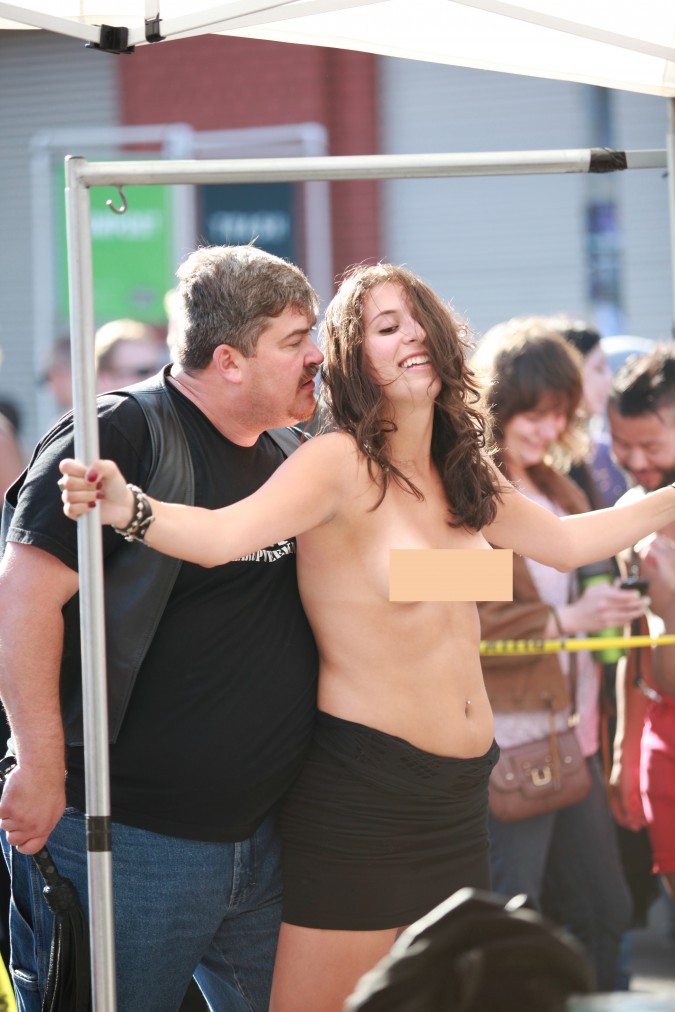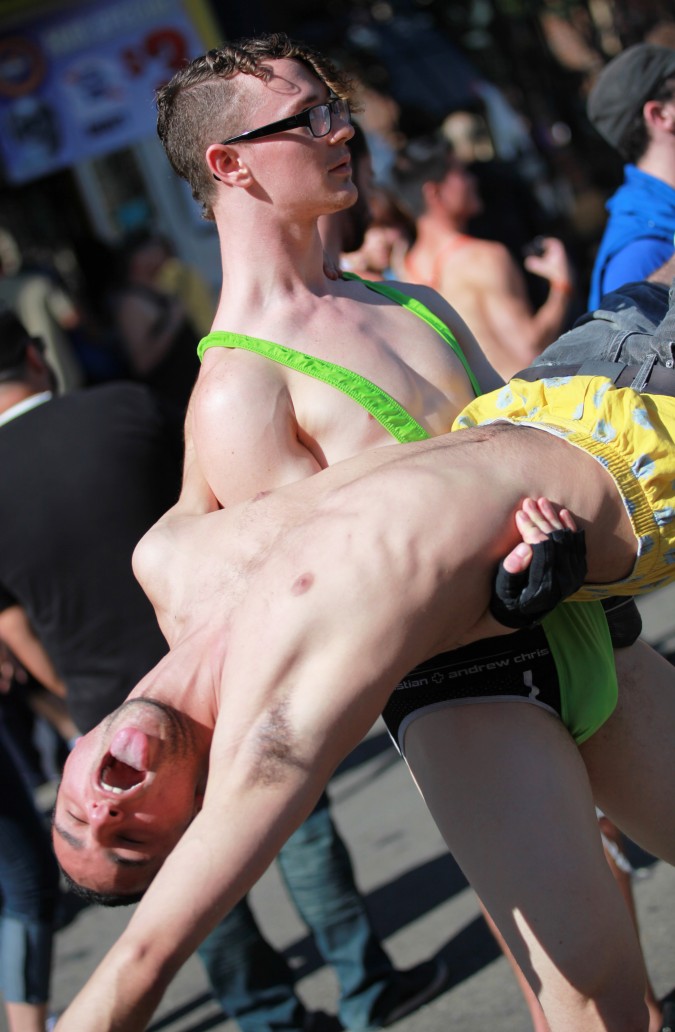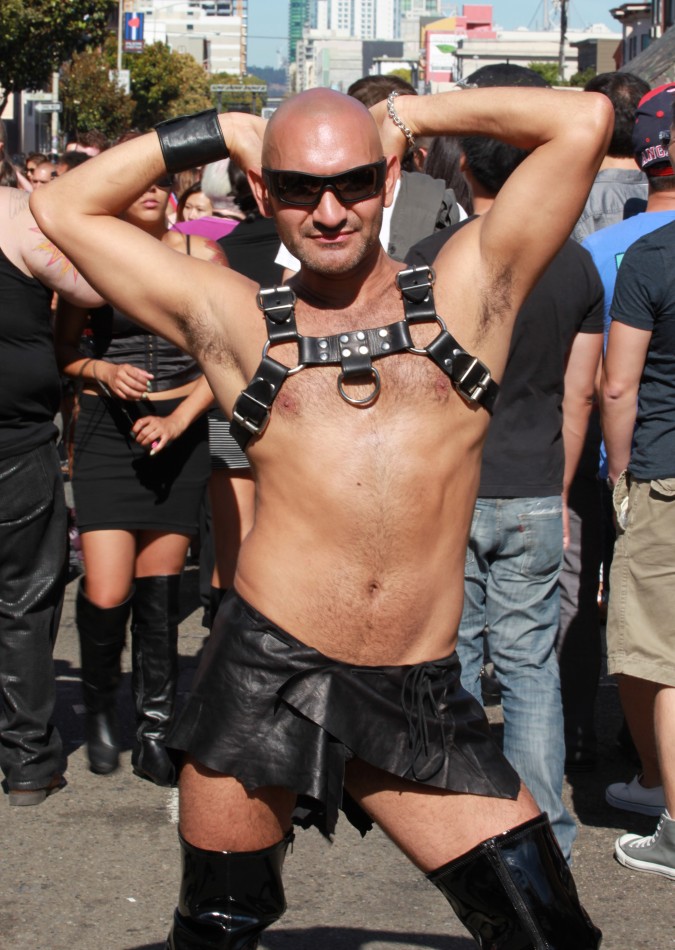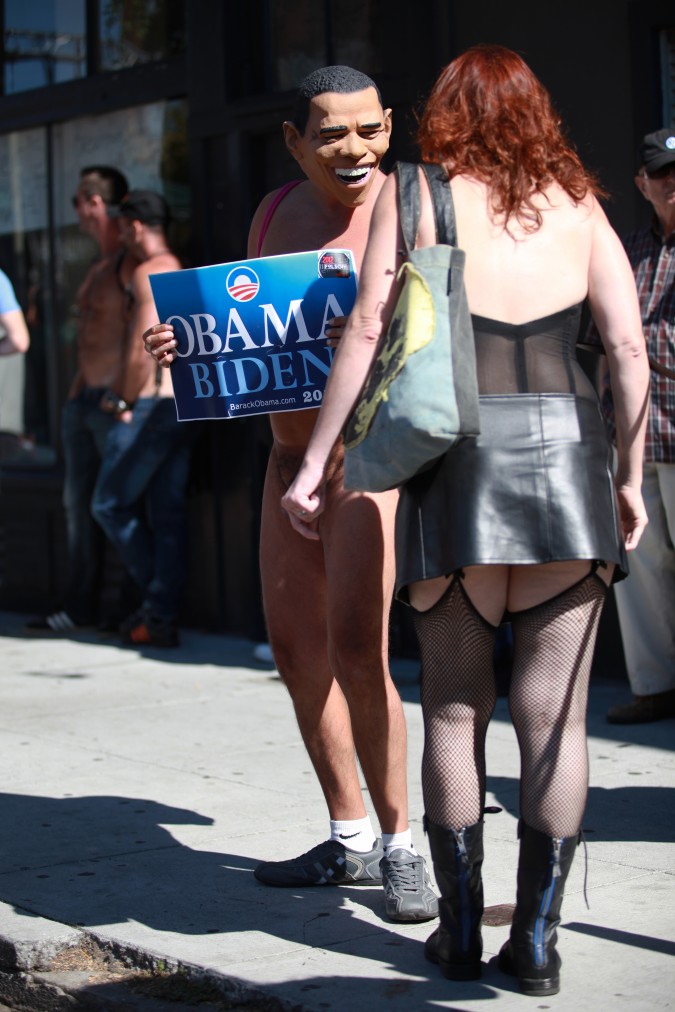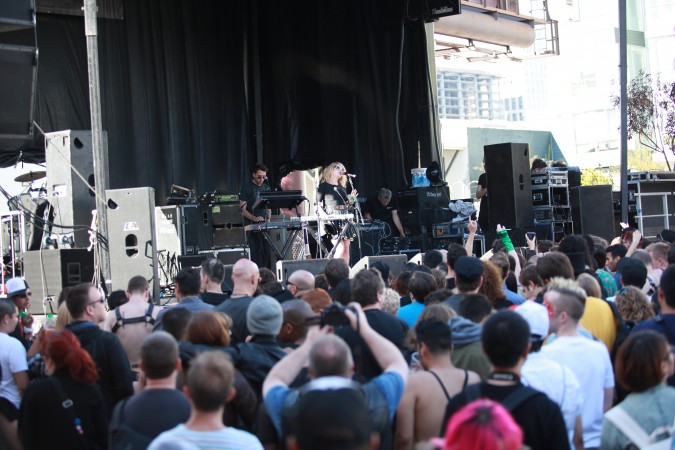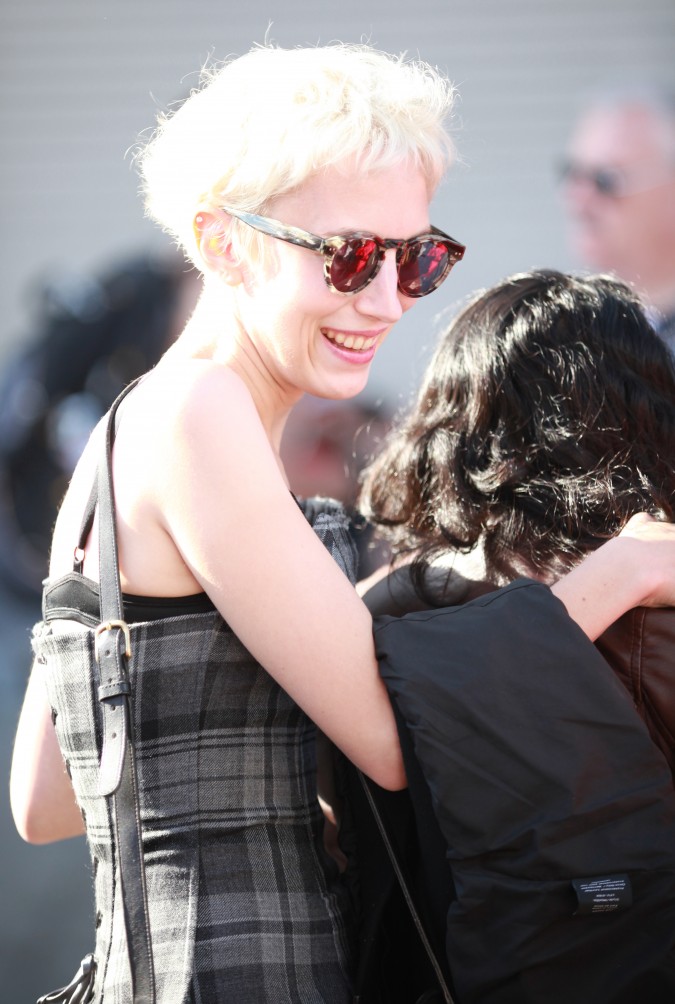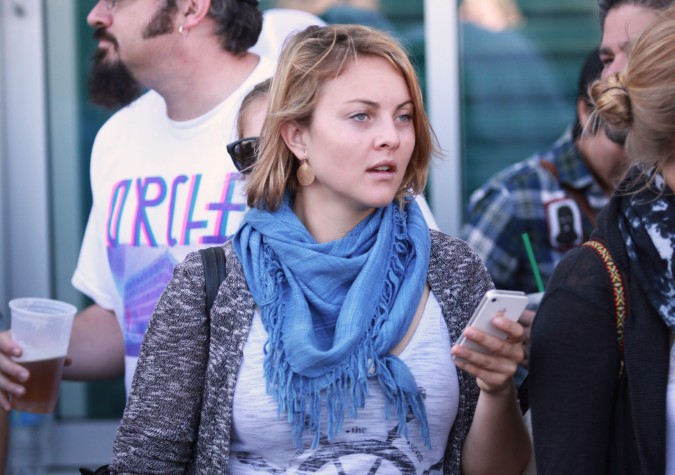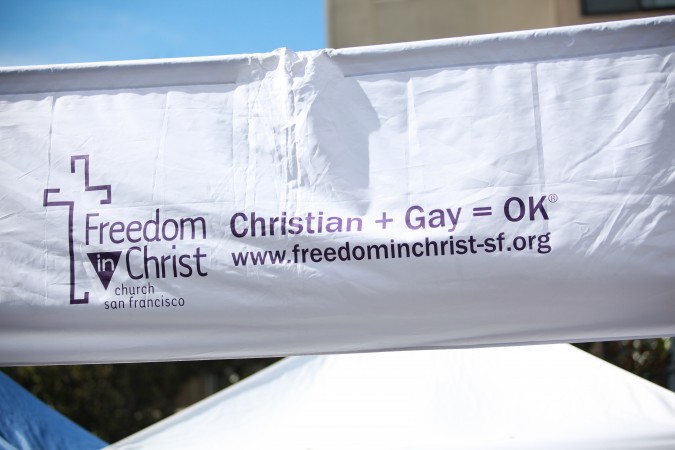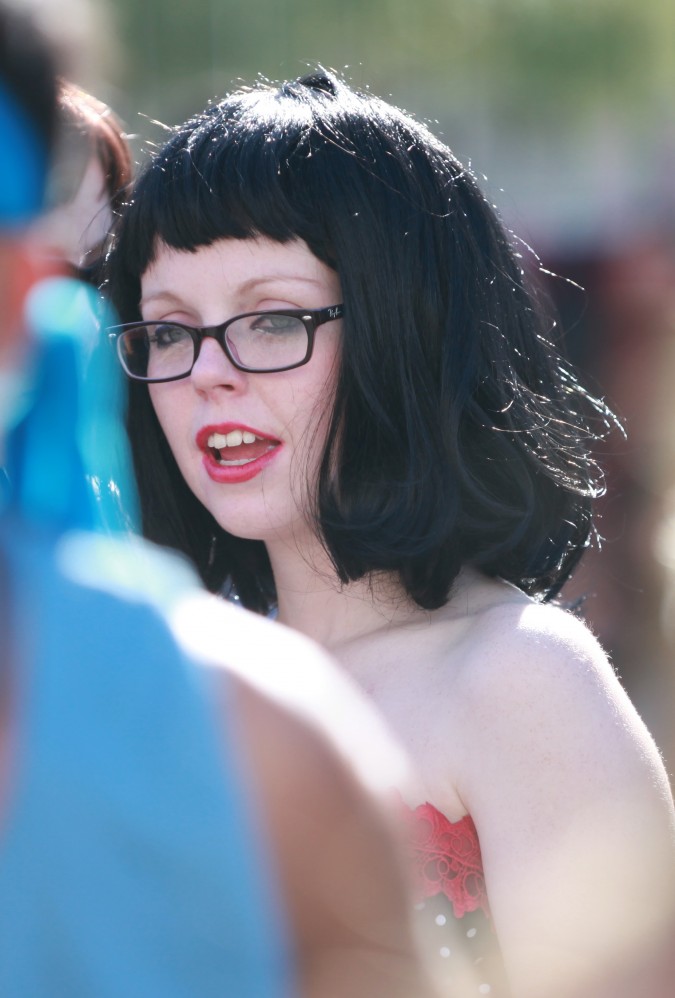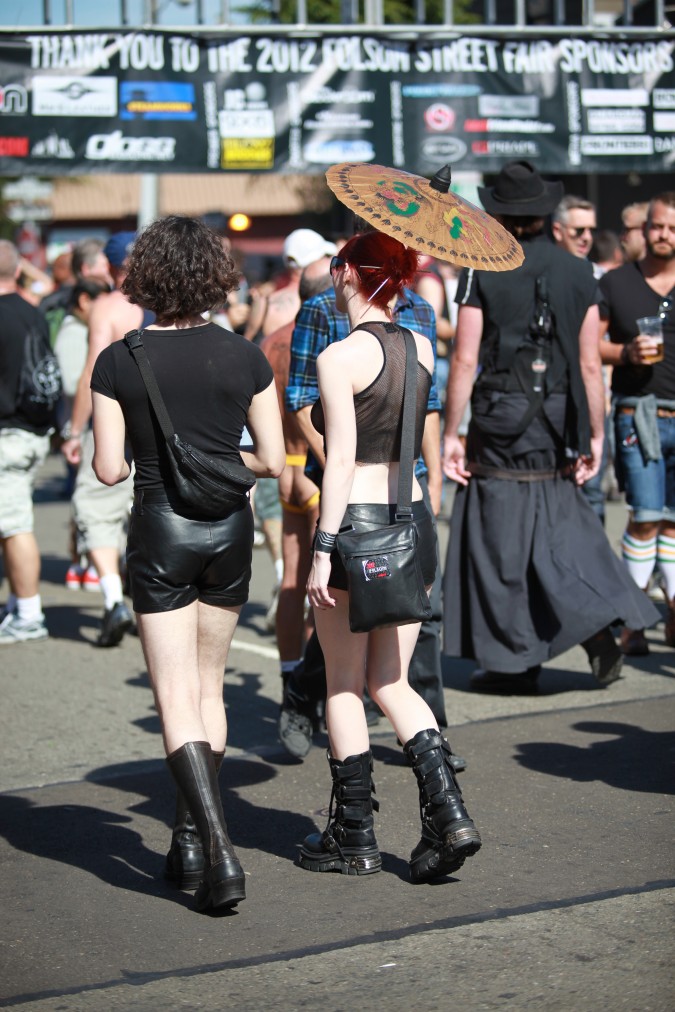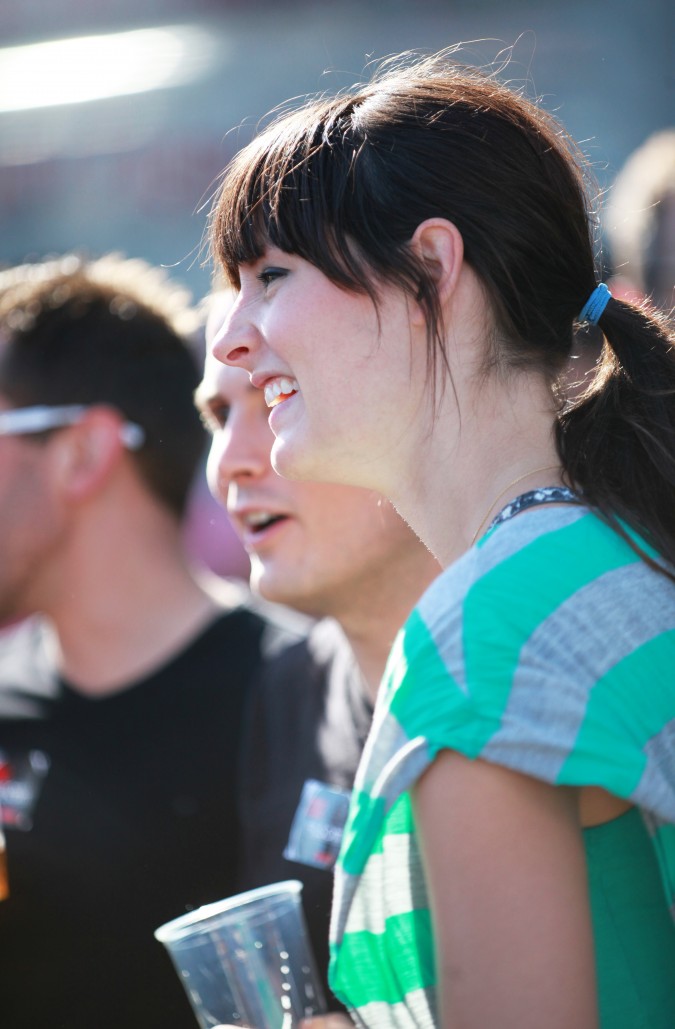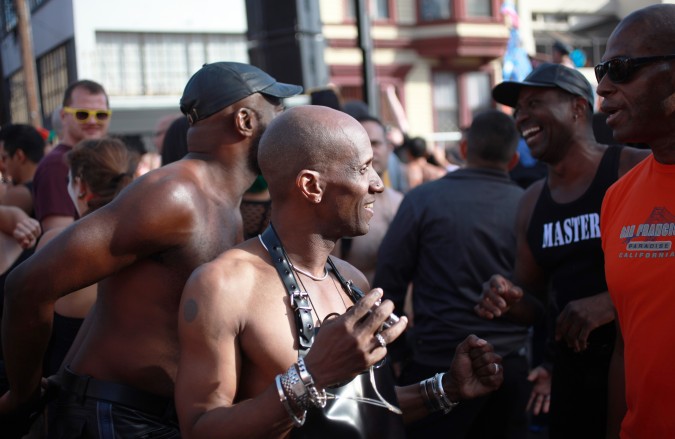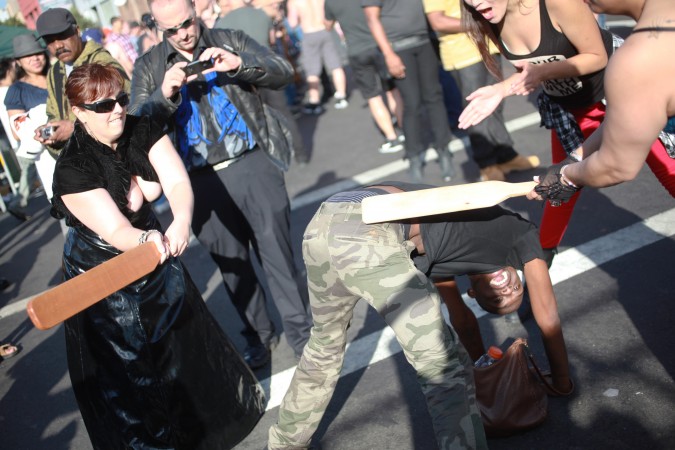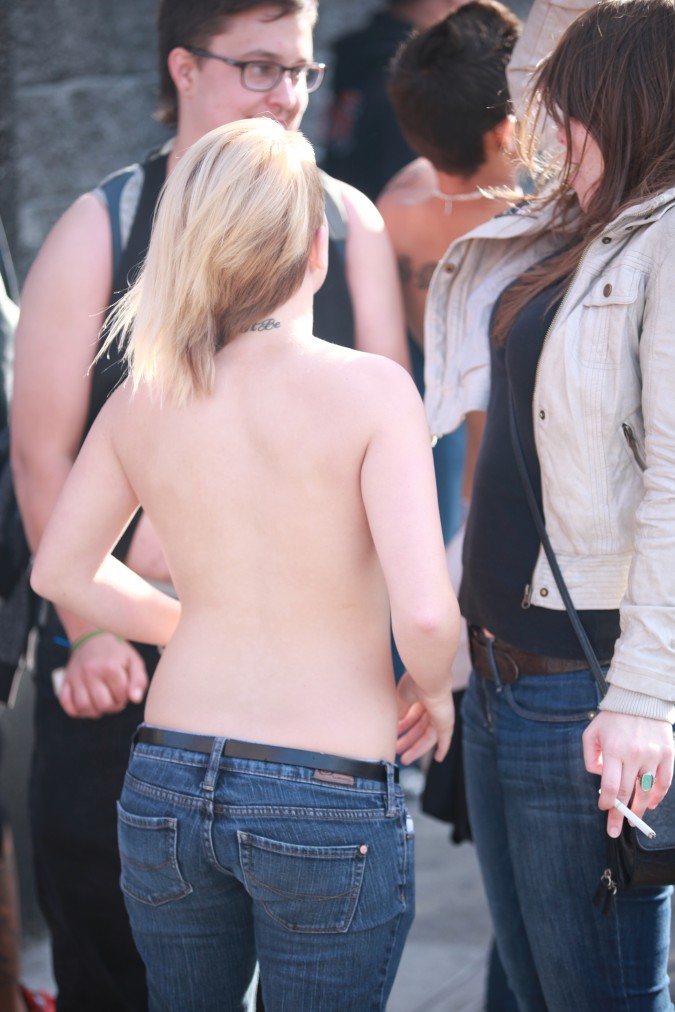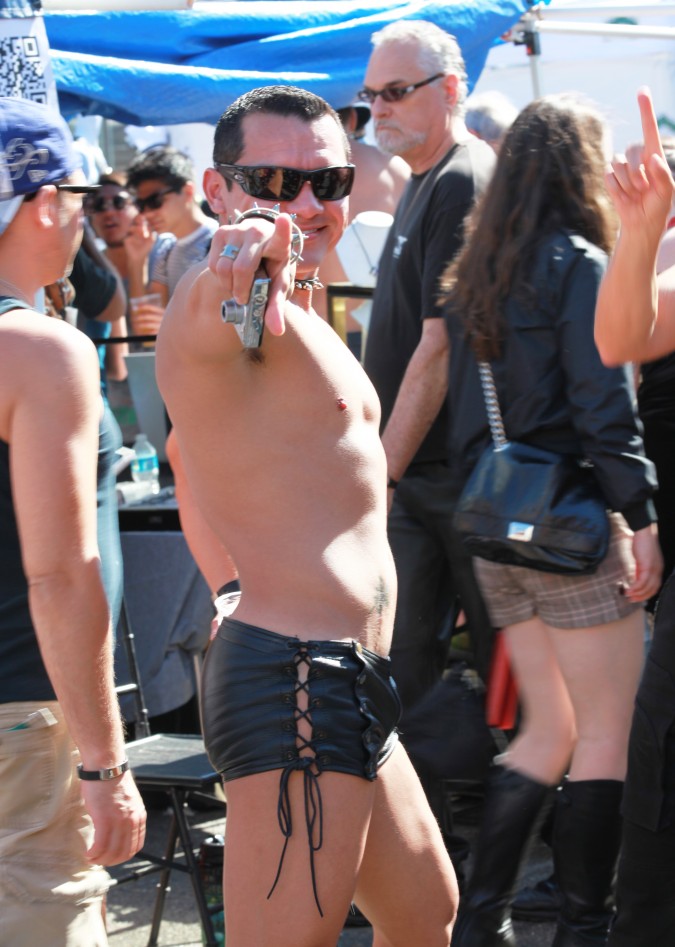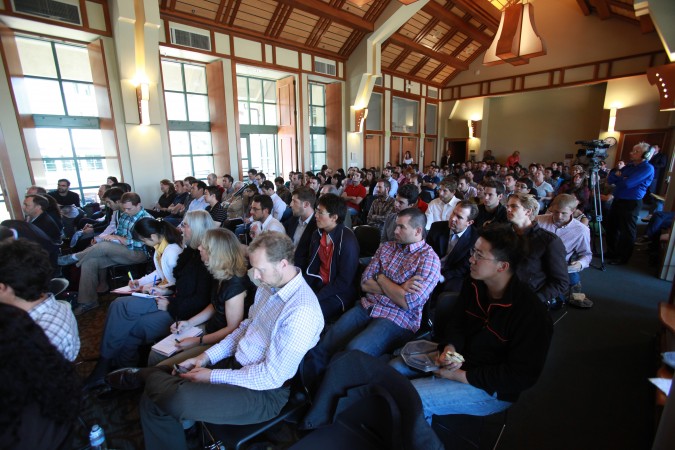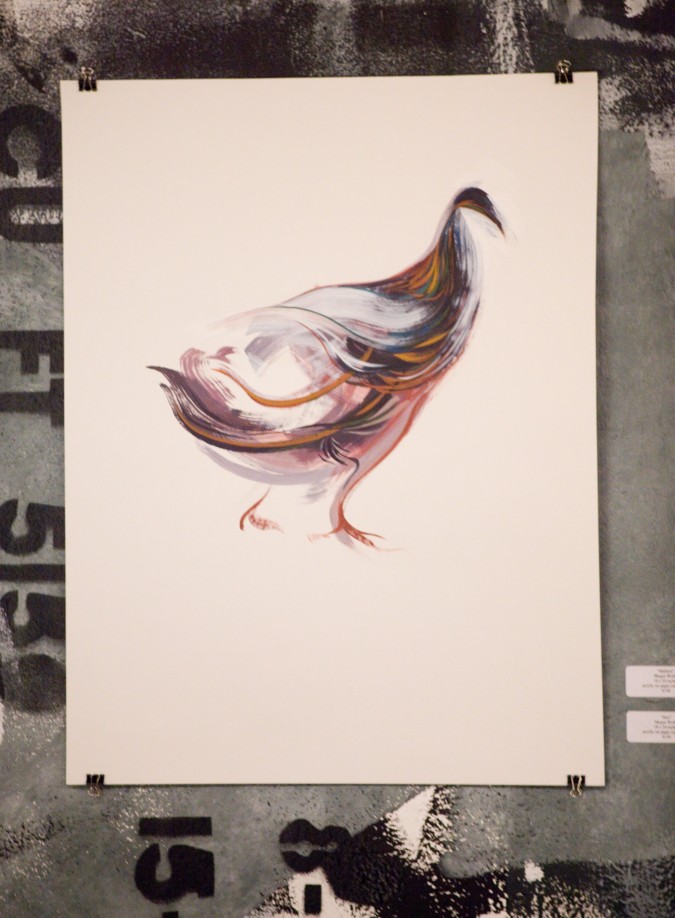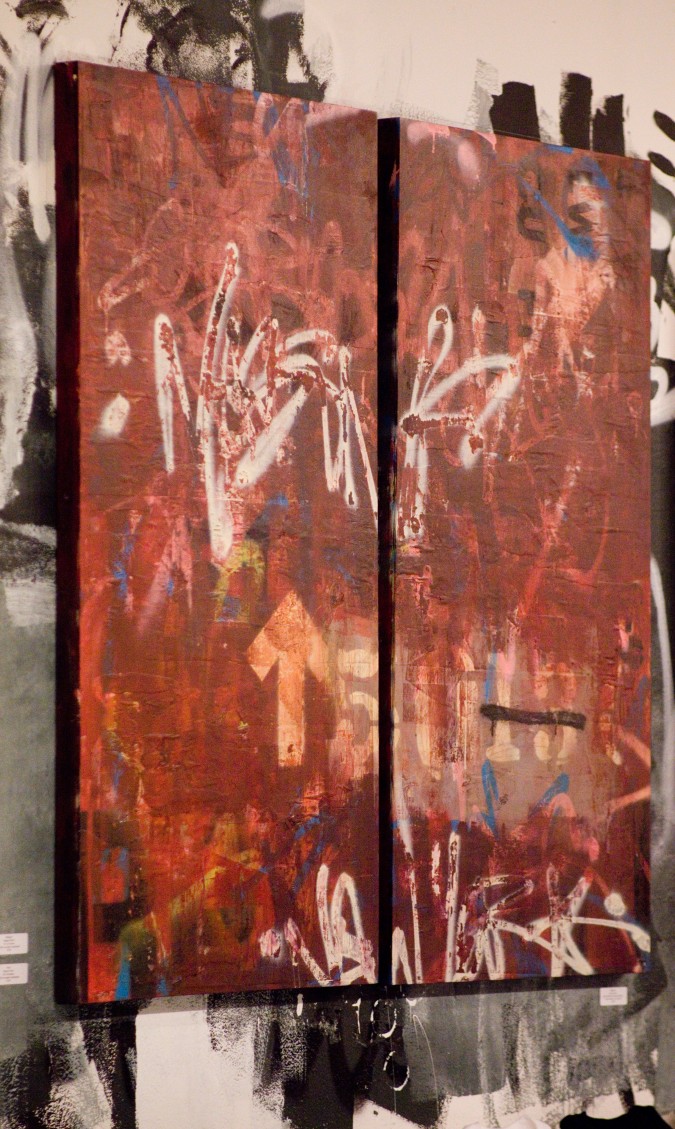Archive for September, 2012
Photographs of Folsom Street Fair, September 23, 2012, San Francisco, California USA
Yesterday afternoon, Sunday, September 23, 2012, I attended the famous Folsom Street Fair in San Francisco, California USA.
The Folsom Street Fair is a BDSM and leather subculture street fair.
The organizer, Folsom Street Events, has a page on Facebook. There is a lengthy article on WikiPediA about the Folsom Street Fair — the largest fair of its type in the world.
This post contains photographs that might be rated PG-13 if this were a Hollywood movie. All nipples are covered in this post, but in some cases just barely, with pasties or adhesive tape. Please skip this post if you are squeamish about nudity or sexuality.
If, however, you want to see more outlandish photographs taken by other photographers, they may be found on Yahoo’s Flickr website. The Flickr pictures are by The Golden Gate Express newspaper.
I took the pictures you see on this page with my Canon 5D Mark II. I used a Canon 50mm macro lens for some of the pictures, and a Canon 70-200 F:2.8 L zoom lens for the rest. Click on the pictures twice in delayed succession to see the images at full size. I uploaded the pictures at maximum resolution and maximum JPG quality of 12.
I have attended the Folsom Street Fair three times in my life — yesterday, in 2010, and in the 1990s.
I am not into BDSM or the leather subculture, but I enjoy the fair.
Yesterday was the first time I went alone, and the first time I brought a good camera with me. I was nervous about being a guy with a camera taking a lot of pictures, but there was no need to be. There were thousands of cameras there. I doubt anyone arrived without a camera. In so many instances, the subjects you see here were actively posing for photographers. Some groups had a dozen photographers at a time trying to photograph them.
There was a lot of full nudity at the fair, especially among the men. I estimate there were 200 completely nude men walking around. I only saw one completely nude woman walking around. There were dozens of topless women walking around, without pasties or tape over their nipples.
I am straight, so I focused more of my energies towards photographing the many attractive women in attendance. I photographed some men too to capture the ambiance of the event and out of fairness.
I gave my card to some of my subjects, and to my amazement, fully half the people I gave my card to emailed me and asked me to send them a copy of the picture I took of them. I happily obliged. Next time I go to the fair, I will offer my card to everyone I photograph, instead of waiting to be asked for it like I did yesterday. One of the women I photographed is a model, and I asked her if she would like to do a shoot with me, and she wrote back that yes, she would. For any of the other women that I have included in this post, I would like to schedule a photo shoot with you as well. You may contact me via Facebook. While you’re there, consider subscribing to my public posts.
I publish a photography blog in addition to this blog at KevinWarnock.com. I only publish results from my photo shoots to my photography blog, not candid images of strangers like you see here.
You may see my photography portfolio at the site ModelMayhem. Model Mayhem is like Facebook for models, photographers and related artists.
The craziest thing I saw at the Folsom Street Fair this year was a nude African American man wearing a rubber Barack Obama mask and holding an Obama/Biden campaign poster. He stood in the same location for hours, allowing himself to be photographed by hundreds of people. Barack Obama is the current President of the United States of America, and he is running for reelection in November, 2012, later this year.
40th anniversary party for the law firm Fenwick & West LLP
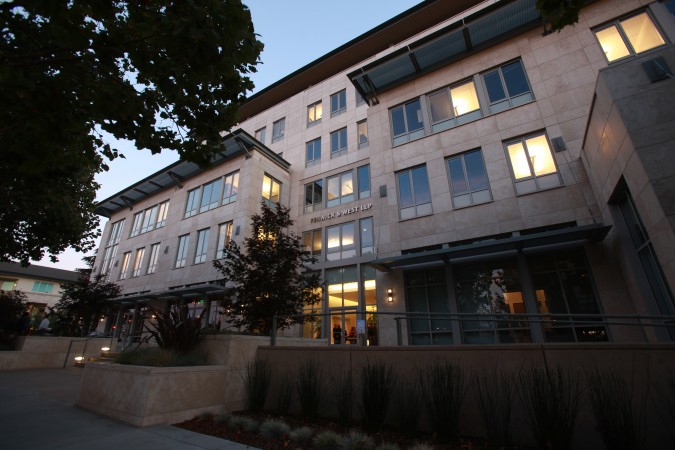
Fenwick and West LLP lawfirm 40th anniversary party September 19, 2012, Mountain View, California USA
Yesterday, Thursday, September 20, 2012, I attended the 40th anniversary party for the law firm Fenwick & West LLP at 801 California Street, Mountain View, California USA 94041.
My friend Sam Angus is a partner at Fenwick & West, and it was through him that I received an invitation.
I brought my camera but did not take it inside. This was a private party, and it didn’t seem right to attend as a blogger, which I typically do when I attend public events.
I did set up my tripod after I left and took this time exposure at dusk of the outside of the building. You can see the party through the front door. Click on this picture twice in delayed succession and you may be able to recognize the faces of the people by the door. You can certainly see the welcome sign on the stand outside the front door.
Fenwick’s chairman Gordon K. Davidson addressed the celebrants and shared some stories from the early days of the firm.
My favorite story was about Apple, Inc.
Fenwick’s first big client was Pioneer, the maker of entertainment electronics. I owned a Pioneer SX-1280 receiver from that era, though I bought it used for USD $100 years after it was manufactured, from my friend Dean Hinton. New it was over $1,000, far beyond my budget at the time. That receiver cranked out 185 watts per channel and weighed more than I did.
Pioneer engaged Fenwick to sue retailers for discounting its products, a type of lawsuit that was allowed back then.
One day Steve Jobs and Steve Wozniak came into their offices to incorporate their fledgling company Apple Computer. This was in the Apple I days — very, very early.
Founding partner Bill Fenwick had the good sense to take on Apple Computer as a client, and, I learned while researching this post, that Bill Fenwick did not charge for the incorporation work because he believed that Jobs and Wozniak couldn’t afford it.
I introduced myself to the hosts. I had a conversation with now retired founding partner Bill Fenwick, who asked if my father is John Warnock, the co-founder of Adobe Systems. I also spoke with current Fenwick & West chair Davidson. Both men were very gracious, and made me feel welcome. I can see how they were able to build a law firm that has become so well regarded.
Fenwick & West is one of the premier law firms in for technology companies.
I saw Dotty Damon Hayes, the mother of a friend, but she apparently departed early and I missed my opportunity to say hello to her again, which I regret.
The food, music, surroundings and guests were first rate. The Fenwick & West offices are understated and elegant. I was particularly impressed that the kitchen area occupies what otherwise would have been a sought after corner office. I spoke with many of the guests, and really enjoyed myself… thanks Sam for the invite.
Happy 40th birthday Fenwick & West!
11 years after 9/11
I am dismayed with how the United States responded to four plane crashes 11 years ago this day, September 11, 2012.
Wars were started that still continue. Trillions of US dollars have been wasted destroying much more than just property and life.
How much better would the world be if President George W. Bush treated the September 11, 2001 events as regular police matters.
Osama bin Laden still could have been found and brought to trial to determine his guilt or innocence, and we wouldn’t have wrecked our good will like we have with these needless and counter productive wars that are a drain on the world. Constant war is a drain on the mental energy of everyone in the world, I fear.
President Bill Clinton handled the 1993 World Trade Center truck bombing as a police matter, and I recall that some of the perpetrators were located, tried in civilian courts, convicted and punished. That’s the way to handle both daily criminal and infrequent catastrophic criminal events.
I believe the people behind the 9/11/01 attacks were upset with how the United States conducts itself on the world stage. I think a sane and proper response would have been to admit to the world that the United States does overstep its place more than it cares to admit. We should have attempted to open a rich and ongoing dialog with those who attacked us to solicit their advice on how the United States could tone things down in the future so that others wouldn’t be so hopping mad that they attack us.
Would such a polite and measured response have worked? I don’t know. But I think it would have cost less in every measure.
If a prestigious entity with world visibility were created where we would yearly sit with our attackers and those who think of attacking, we would have taken the wind out of the sails of our attackers to a substantial degree. The entity would need to have power, prestige and money for it to be seen as more than window dressing by those who might attack us. It would need to make sure action was taken after meetings so all those watching would know their voice was being heard and acted upon. This would be one heck of an organization, and I don’t know how to pull it off, but it needs to be built. We know how to build huge, costly organizations that can cause action. The US military is one such huge costly organization, for example. The organization for good I propose might need to rival the US military in size, scope, power and budget. That might sound crazy, but what really are we getting for our military expenditures now? I would argue a lot less than nothing. We are building negative equity like at no time in the history of the United States. We could fund the organization I propose by reallocating half the budget of the US military as a start. With just half its budget intact, the United States would still have a huge military, but we would also immediately have the largest organization for world change on the planet, and just by having made that commitment, I predict more than half our ‘need’ for a military at all would evaporate. Half of our military is still a lot, and think of the new friends we would make with the new organization for change I propose. Far fewer people would wish us harm if we were doing good on such an intense global scale.
Now prepare yourself for the most provocative text I’ve written in my life…
Soon after the September 11, 2001 plane crashes, United States of America President George W. Bush should have said something like this:
“The United States is profoundly sorry and embarrassed.
Without an invitation, the United States has been acting like the policeman of the world.
We recognize that there are other valid points of view on how to live life. We don’t want to be attacked like this again, so I ask those of you who wish us harm to please share with us how we can avoid such attacks. We are willing to make big changes, and we’re willing to spend a lot of money to be a nicer world citizen. To demonstrate our resolve to change and see the point of view of others, the United States today is contributing USD $100,000,000,000 to get the ball rolling towards a more fair and sane planet. We will spend to improve the lot of the people that attacked us.
On behalf of the United States of America, I am sorry that this country has acted such that you believe you had to attack it. While this country may not agree with your points of view, it does recognize that you view your points of view as valid and worth advancing. Clearly, we need to talk, and we will talk. I personally will talk face to face with your representatives.
The United States feels so strongly that it will learn to play nice on the world stage that beyond the USD $100 billion I just spoke of, I am committed to working with the US House and Senate to gain approval to spend up to USD $3,000,000,000,000 over the next decade to fix what’s wrong with the world.
The United States is not a vindictive nation.
The United States could respond by starting wars and destroying entire countries, but we’re bigger than that, and we will show our attackers that the people of the United States are your friends, not your enemies. War is terrible. Peace is golden. The United States stands for peace, not war.
On behalf of everyone in the United States, including the families of those who lost loved ones today, I appologize for our actions, attitudes and positions that led others to believe that they had to attack the United States so violently to get our attention.
With hard work and determination, today will be the last time that any people of the world should feel that they have to attack us to get us to change our overstepping ways.
The United States in fact is ashamed that it has come to this, that we have upset other people so dramatically and profoundly that they have responded by flying airplanes into our landmarks, ending the lives of so many earnest people in the process.
Let us spend the following ten minutes in silence to reflect on the enormity of the events of today. Let us imagine a world filled with peace, happiness and enough to eat and drink. Let us cast aside our revengeful impulses so that we can come together at a meeting table to plan how the people of the world shall overcome the horror of today in favor of the brightness of a more promising future for all of humanity.
To the friends and family of those who lost their lives today, if you want to be upset with somebody, be upset with me and the past Presidents of The United States of America. What happened today was a reaction to this country overstepping its place in the world. It simply is not nice to tell other people how to live while we consume such a disproportionate percentage of the resources of the planet. In the decades ahead, we will need to learn to share our bounty with others more than we have done so far. Look on this redistribution of wealth as your insurance payment for the future safety of you, your property and your loved ones, not as a handout. The United States has been acting like a rich, spoiled kid on the playground eating the finest candy and laughing while others nearby starve and have little. We can remain a wealthy and prosperous and happy nation while at the same time leveling the playing field. We are a nation of thoughtful and ingenious innovators, and if we put forth our full effort, perhaps 100 times greater than what was required to place a man on the moon, we can solve the really big problems the world today faces.
Three trillion dollars is a lot of money. We can spend that amount building peace, love and goodwill. We can also spend three trillion dollars killing hundreds of thousands of people and destroying countries.
I am certain that three trillion dollars of peace, love and goodwill is more valuable than three trillion dollars of rubble, hate and death.
May September 11, 2001 be viewed by history as the first day of the most kind and peaceful period the world has yet known.
For those of you that worship a higher power, may that higher power give you comfort on this historic day of new beginnings. Let us rejoice in the saved lives of the hundreds of thousands of people this nation will not kill in response to the events of today. Let us rejoice in the new lives of the hundreds of thousands of babies by coincidence born this historic day. It is tragic that the United States lost thousands of its residents today, but keep in mind more babies were born in the United States today than lives were lost in these four plane crashes.
The United States is your friend, not your enemy. The United States wants peace, prosperity and fairness for all the people of the world.
Tomorrow will be better.
I love you.”
Instead, President Bush said something genuinely and dramatically stupid:
“You’re either with us or you’re with the terrorists.”
This is such an unwise thing to say it sounds like something out of the mouth of a high school student at a third rate institution. Yet his short statement formed the basis for spending of even more trillions of dollars than I proposed the United States spend in my mock speech above.
The United States ruined itself by its unwise response to four plane crashes.
I don’t spend a lot of time delving into the deep details of world politics. I am not a historian. I am not particularly well informed about what I write about here. I admire Noam Chomsky and Dennis Kucinich. I think Chomsky and Kucinich would like what I have written here today. I hope to meet both men one day, perhaps in response to this post if I am really lucky.
I believe I possess a very fine and properly working moral compass. I am proud of and guard my moral compass. I’ve made profound and life altering changes in my life when needed to protect and guard and respect my moral compass, even when it would have been so easy for many others to compromise. Perhaps the above makes me look childish and unrealistic. Perhaps I will lose a friend or three by what I’ve written. But what I’ve written has been on my mind for ten years now, and today I decided to just say what I first thought starting about 2 seconds after I first heard about the first plane striking one of the towers of the World Trade Center complex in New York City, New York, USA.
The United States has ruined itself by its response to four plane crashes.
Why?
PS – I am sorry for the loss of the family and friends of those who lost their lives in the events of and following September 11, 2001. By writing this post, I do not intend to upset anyone who lost a loved one. My heart also goes out to friends and family of those who have been killed or injured in the response to the events of 9/11, including those serving in military forces on all sides. I love the United States, and I love people generally, from all countries. I am so sad that all this death and suffering and hate has happened. It’s all so unnecessary and wasteful. Thank you for reading. I love you.
Kevin Laurence Warnock
San Francisco, California USA September 11, 2012
Note: I published this post on September 11, 2011, the 10th anniversary of the 9/11 attacks.
Today, September 11, 2012, I published this post again, changing the first sentence from “I am dismayed with how the United States responded to four plane crashes 10 years ago this day” to “I am dismayed with how the United States responded to four plane crashes 11 years ago this day, September 11, 2012.”
I am proud of this post, and I plan to republish it annually on September 11th.
AT&T CEO Randall Stephenson is interviewed September 6, 2012 by Rich Lyons, the Dean of the Haas School of Business at University of California Berkeley

Rich Lyons, Dean of the Haas School of Business at UC Berkeley interviews Randall Stephenson, the CEO and Chair off ATT, September 6, 2012. Photograph by Kevin Warnock.
On Thursday, September 6, 2012, I attended the Dean’s Speaker Series at the Haas School of Business at the University of California at Berkeley, in Berkeley, California USA.
This was the first Dean’s Speaker Series I have attended.
I have been aware of this series for years, but I assumed attendance was restricted to friends of the Dean, Rich Lyons, because of the name of the event.
I’ve met and spoken with the Dean about ten times over the years, I estimate, including when he was the Acting Dean when Dean Tom Campbell took a leave of absence to help then Governor Arnold Schwarzenegger manage the finances of the State of California.

Rich Lyons, Dean of the Haas School of Business at University of California Berkeley, asks Randall Stephenson a question, September 6, 2012. Photograph by Kevin Warnock.
A couple of weeks ago I was looking over the Haas website and marveled at the outstanding list of upcoming individuals the Dean will be interviewing on stage. There in front of me were the magic words — the events are open to members of the Haas ‘community.’ I was pretty sure I qualified, since I am a sponsor of one of the school’s premier events, the Berkeley Startup Competition, and have been every year since 2000. I inquired and I got a seat — I was and am thrilled.
The Dean’s guest for this event was Randall Stephenson, the Chief Executive Officer of AT&T, the largest telecommunications company in the United States.
I am an AT&T customer, both for my home’s broadband Internet connection and for my wireless Apple iPhone 3GS, which I bought soon after launch. I no longer have a wired phone. I like AT&T’s service — I get great reception and few dropped calls.
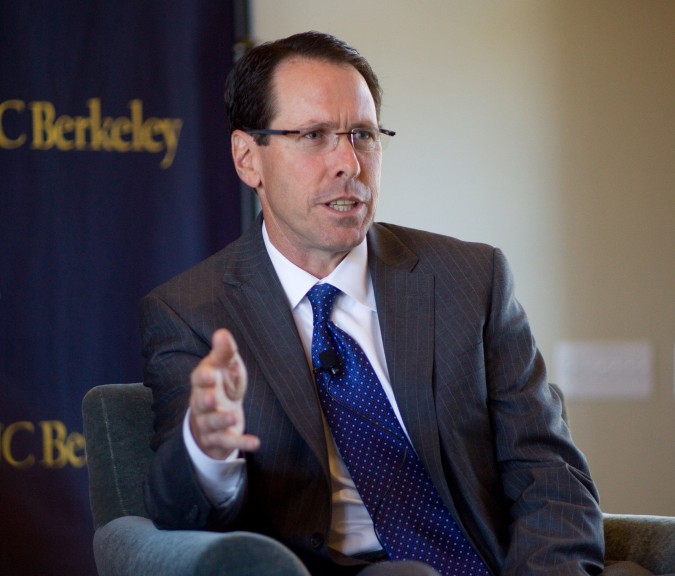
Randall Stephenson, Chair and CEO of AT&T, photographed by Kevin Warnock on September 6, 2012 at UC Berkeley
My regard for AT&T went up after listening to Stephenson speak for an hour. Stephenson was Chief Financial Officer and Chief Operating Officer prior to becoming Chair and CEO, among many roles.
He started at a job he called a ‘tape monkey’ at Southwest Bell Telephone in 1982 loading 19 inch diameter magnetic tapes of billing data onto tape drives. He did this work 12 hours a day — reading a video screen for instruction on which tape to load, finding the tape in storage, loading the tape and then pressing ‘Run.’
I did this same job, though not full time and not for 12 hours a day, when I worked at Cooley LLP. Thankfully I only had to do this role about two weeks a year, when the regular tape technician, Bill Calhoun, went on vacation.
Stephenson said he figured a way to rework his tape loading job to make it much more efficient and enjoyable, though he didn’t tell us the details of what he changed.

Rich Lyons, Dean of the Haas School of Business at University of California Berkeley, listens to Randall Stephenson answer a question, September 6, 2012. Photograph by Kevin Warnock.
During his introductory remarks, Rich Lyons said Stephenson worked in Mexico City as SBC’s Director of Finance.
At some point, Stephenson worked in Mexico for Carlos Slim, the iconic leader of Telmex. Stephenson did not explain how he came to work for Carlos Slim, who presumably was not an SBC employee at any point in his life.
Stephenson said Carlos Slim is ‘the most inherently brilliant individual that I’ve ever worked with.’
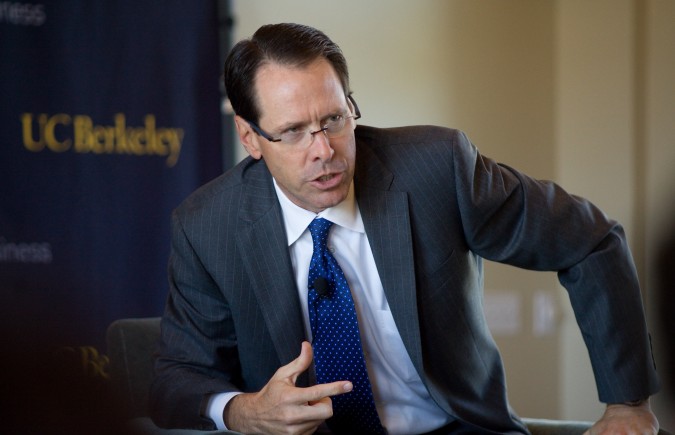
Randall Stephenson, CEO and Chair of AT&T, speaks at University of California at Berkeley, September 6, 2012. Photograph by Kevin Warnock.
Stephenson was in Mexico working for Slim in 1994 when there was an economic crisis that began December 19, 1994, when the Mexican government lifted all restraints on the Mexican Peso and let its value float. The Mexican currency lost 40% of its value in one day, Stephenson recalled.
Slim had 20,000 wireless subscribers in 1994, and thanks in part to the aggressive investments Slim made in the aftermath of the economic crisis of 1994, TelMex now has over 200 million wireless subscribers and Slim has made himself reportedly the wealthiest man in the world.
Stephenson took his job as CEO in June 2007 when ATT was a $100B annual revenue company with 300,000 employees, the same month that Apple launched its first iPhone. Stephenson invested heavily when the 2008 financial crisis came.
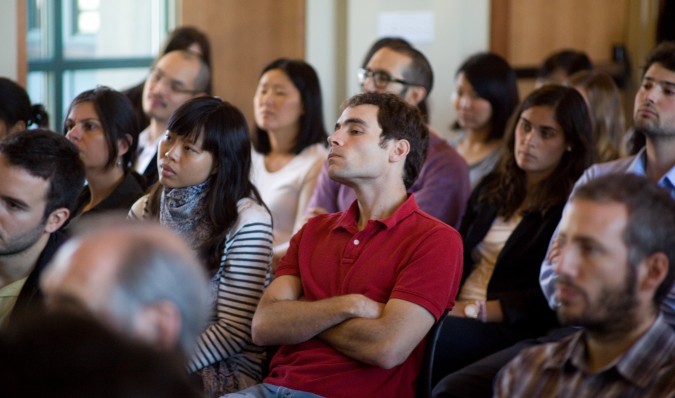
University of California Berkeley students listen to AT&T CEO and Chair Randall Stephenson speak, September 6, 2012
Stephenson said that 170,000 of AT&T’s employees actively participate in its TIP — The Innovation Pipeline — system conceived by the company’s CTO, a guy so tough to hire that it took ten years for Stephenson to do so. This system allows employees to propose ideas for the company to work on developing. People vote on the ideas and the best ones that float to the top are funded and pursued. In response to a question from a student in the audience, Stephenson said that apart from advertising the program to employees the company does little to promote participation. He said participation is quite good.
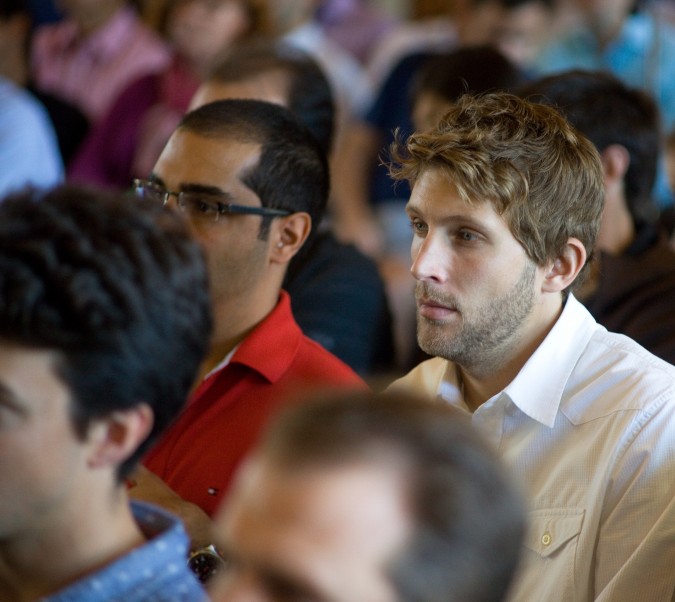
University of California Berkeley students listen to AT&T CEO and Chair Randall Stephenson speak, September 6, 2012
Stephenson and and his public relations person Larry (last name not mentioned) said they were so excited about a couple of their ‘tattooed up’ technologists in their Palo Alto, California research lab named the ‘Foundry’ that they put photographs of them in AT&T’s Annual Report. Stephenson divulged that competitors now are ‘coming after’ these programmers trying to hire them away from AT&T.

University of California Berkeley student asks AT&T CEO Randall Stephenson a question about AT&T's TIP suggestion system, September 6, 2012. Photograph by Kevin Warnock.
A student from the audience asked Stephenson to discuss wireless handset subsidies. Stephenson answered at length and concluded that the current system in the United States is overwhelmingly what customers want. He said AT&T performed studies where customers were asked if they would like to finance a phone via a separate finance contract, in exchange for markedly lower rates for service. Stephenson said customers did not like this proposal.
I think the survey respondents that answered this way are short sighted.
The way things operate in the United States, where one can buy a USD $700 iPhone for $200 because of the carrier subsidies, there is a perverse incentive to upgrade your phone exactly every two years. That is because contracts generally run for two years. If you keep a phone for three years, that final year you are paying much more than is warranted for service.
People should be encouraged to save money, not spend, so I admire the relatively new system reported by Stephenson to be the norm in Europe — phones are not subsidized and rates for service are [I hope] commensurately lower. Stephenson said phone sales dropped dramatically when this policy was implemented, but I say that is just what the world needs. People keep a home phone for decades. People keep televisions, stereos and other household appliances for years. Stephenson told me one-on-one after the event that fully 90% of his company’s customers upgrade their wireless phone every 14 months. Since contracts are two years long, 90% of its customers are paying early termination fees, which decline over time. That is a waste of the world’s resources, even in this day of a vibrant resale market for used mobile phones. I’m pretty sure a lot of people just throw their old mobile phones in a drawer, to benefit nobody. I understand mobile phones improve rapidly, and I do plan to get the latest iPhone when it’s available, having skipped the iPhone 4 and iPhone 4s. I just don’t approve of upgrading exceptionally frequently, which I consider 14 months to be.
I encourage AT&T and all carriers to offer unbundled rates for mobile service, as an option.
Rich Lyons is a good interviewer. The setting was photogenic — two handsome cushioned arm chairs on an elevated stage, with a small end table between the chairs. Lyons and Stephenson wore wireless lapel microphones. There was a backdrop behind the men that repeated the logos for UC Berkeley and the Haas School of Business, so the logos made it into every photograph of the people on stage. As a photographer, I applaud the Dean for creating such an inviting, warm and photogenic environment for his interviews. I look forward with enthusiasm to the next Dean’s Speaker Series interview, which I hope to be able to attend.
Former Haas Dean Dr. Laura D’Andrea Tyson is on the Board of Directors of AT&T, and presumably she helped Lyons recruit Stephenson to visit the Haas School. Tyson was Dean when I was a finalist in the Berkeley Business Plan Competition in 1999 with my company Hotpaper.
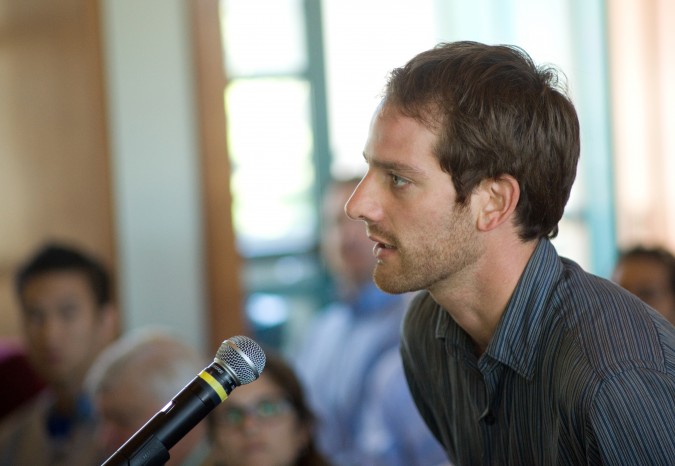
Student asks AT&T CEO and Chair Randall Stephenson a question about mobile handset subsidies, September 6, 2012, at University of California Berkeley
I took the photographs that accompany this blog post.
I used a Canon 5D Mark II camera with the following lenses: Canon 135mm soft-focus lens set to sharp, Canon 16-35mm L zoom lens. I upload pictures to this blog at maximum camera resolution at maximum image quality. Click on the photographs twice in delayed succession to see the full size images. If you would like to use these pictures, please send me a message. If the purpose is reasonable, I will allow usage. I enjoy having my pictures displayed elsewhere. I pursue photography only as a hobby, not as a profession.

At the end of his interview, Rich Lyons stands with ATT CEO and Chair Randall Stephenson at the Haas School of Business, September 6, 2012. Photograph by Kevin Warnock.
Finally, I have some advice for Berkeley students reading this post — introduce yourself to the speaker.
I don’t recall seeing any students introduce themselves to Stephenson. I did see a professor and a president of a good sized company say hello, but that’s it. Stephenson spent several minutes talking with me because there was nobody waiting after me to speak with him. The room had rapidly cleared out. The interview was during the lunch hour, so perhaps the students had to be in class immediately after. It’s rare for so prominent a CEO to speak to such a small group — there were about 140 students in the room by my quick count. I’m sure Stephenson won’t be back this academic year. Make a point of meeting all such prominent speakers. In my mind, Stephenson should have been surrounded by dozens of students trying to shake his hand. Stephenson didn’t appear to be in a rush to depart, and I left before he did.
Art opening at D-Structure in San Francisco featuring art by Steve Javiel, Daniel Valadez and Megan Wolfe
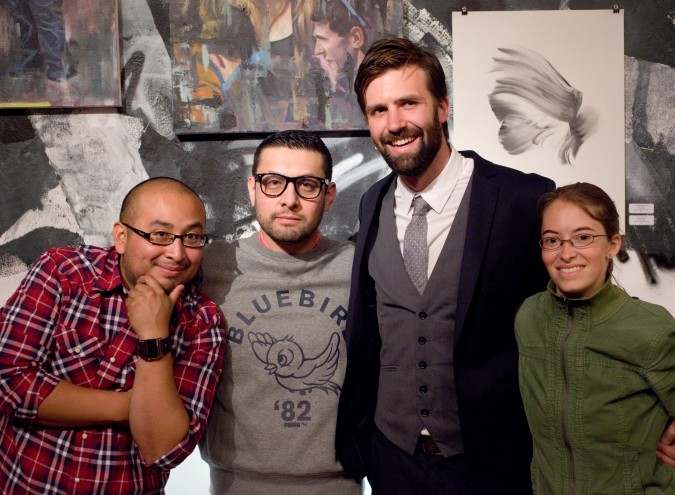
Steve Javiel, Daniel Valadez, Devon Chulick and Megan Wolfe at D-Structure, September 7, 2012. Photo by Kevin Warnock.
Yesterday evening, Friday, September 7, 2012, I attended an art opening at the hip clothing boutique and art gallery known as D-Structure.
I last wrote about D-Structure when the store hosted a trunk sale for Modify Watches.
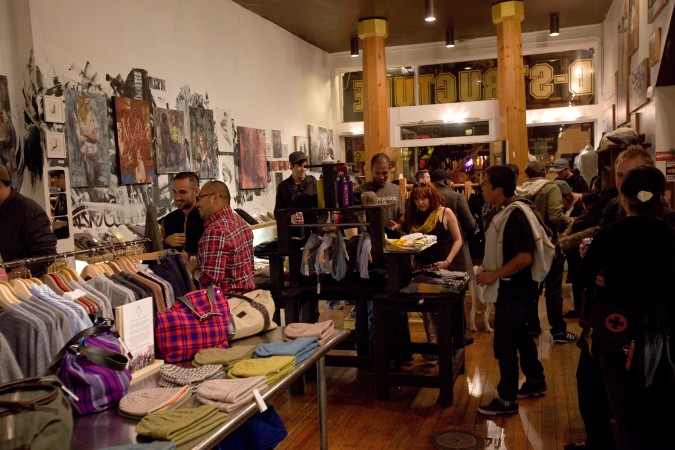
Art opening at D-Structure at 520 Haight Street, San Francisco, California, September 7, 2012. Photo by Kevin Warnock.
Devon Chulick, the new President of the Lower Haight Merchant Association, and the co-owner of D-Structure, introduced me to the artists — Megan Wolfe, Steve Javiel and Daniel Valadez.
The artists spent over 12 hours painting the wall that their artwork is displayed on, which you can see in the photographs above. Since this is original artwork, perhaps Chulick will find buyers for the drywall before this show is complete, to avoid having to paint over the large format piece. I loved the wall painting, as it tied the work of the three artists together, even though their styles are distinct.
I was in a rush to get to another art gallery opening, so I only spent about 45 minutes at the show. I didn’t get to interview the artists or really study the artwork, sadly, so I am sorry I can’t write a full blog post about this show. I like the art, particularly that by Javiel. I invite you to visit the websites of the artists, where you can see better quality photographs of their work. The color quality of the photographs I shot of their work is likely to be far off, as the lighting was not ideal for making accurate representations. The lighting was ideal for creating a warm and inviting atmosphere for an art opening.
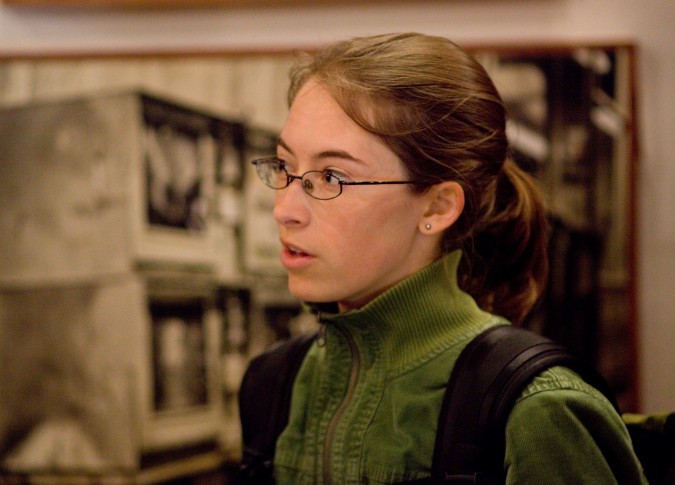
Megan Wolfe at her art opening at D-Structure, September 7, 2012 at 520 Haight Street, San Francisco, California USA

Steve Javiel at D-Structure gallery opening at 520 Haight Street, San Francisco, California USA. Photo by Kevin Warnock, September 7, 2012.
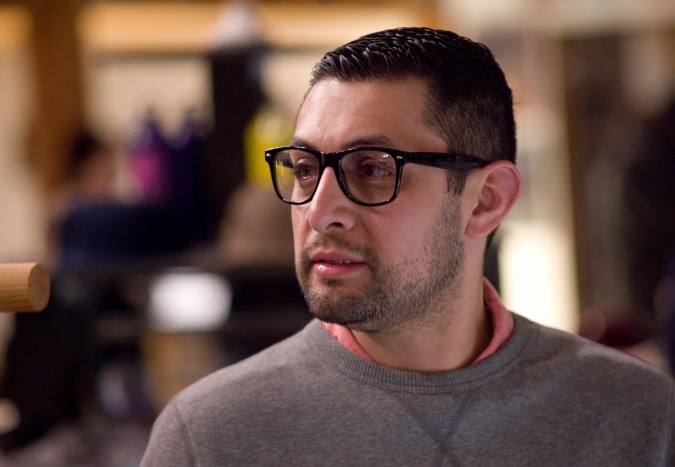
Daniel Valadez at D-Structure gallery opening at 520 Haight Street, San Francisco, California USA. Photo by Kevin Warnock, September 7, 2012.
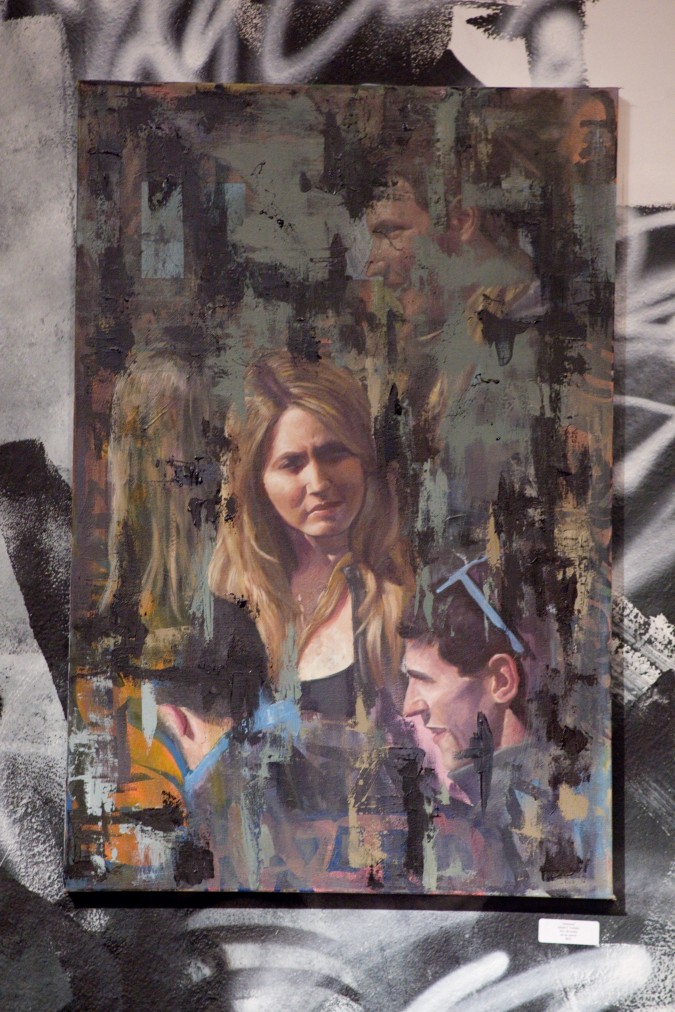
Artwork by Daniel Valadez at D-Structure gallery, September 7, 2012, 520 Haight Street, San Francisco, California USA
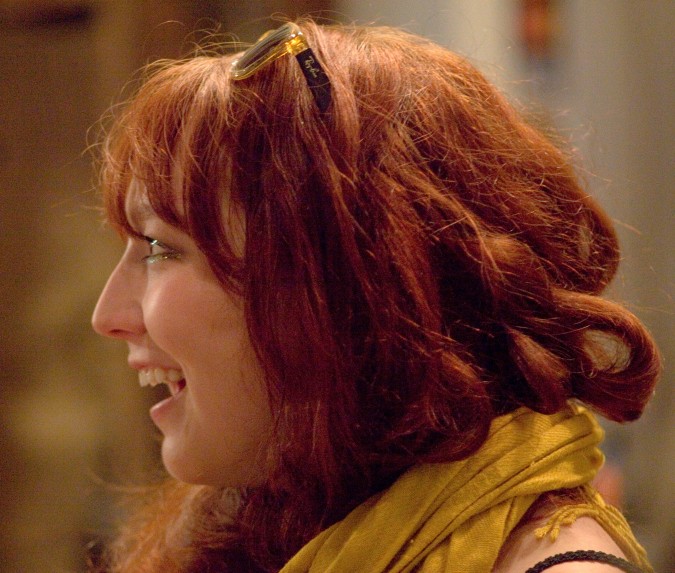
Jenya Rafi at D-Structure art opening at 520 Haight Street, San Francisco, California USA, September 7, 2012
To see these pictures at full resolution of 21 megapixels, please click on them twice in delayed succession. I used a Canon 5d Mark II camera and the following lenses: Canon 135mm soft-focus lens set to sharp, Canon 50mm macro lens, Canon 16-35mm L zoom lens.
Hana Alyssa Sidia gets the credit for my attending this art opening. I met Sidia at the Modify Watches event and she invited me to attend the art openings which she says D-Structure stages about once a month.
Click here to see all the posts I have published to this blog about D-Structure
Berkeley Entrepreneurs Forum, 2012-13 Angel & Venture Capital Financing Overview – August 30, 2012

The Berkeley Entrepreneurs Forum, August 30, 2012, held at Stanley Hall, room 105, because Anderson Auditorium was booked
On August 30, 2012 I attended the 2012-13 Angel & Venture Capital Financing Overview at The Berkeley Entrepreneurs Forum.
The August 30th Forum was the first of this academic year. The Berkeley Entrepreneurs Forum is a production of The Lester Center for Entrepreneurship & Innovation at the Haas School of Business at the University of California Berkeley.
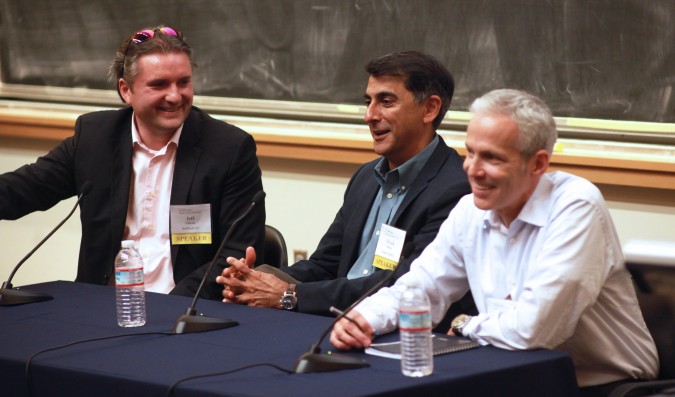
Panelists Jeff Clavier, Vivek Mehra and Jim Barnett at Berkeley Entrepreneurs Forum, August 30, 2012. Photo by Kevin Warnock.
The first Forum of the year for years now starts with Steve Bengston’s presentation of the Shaking the Money Tree report. I suspect Bengston has made this presentation hundreds of times, as he gives it not just at the Forum, but at many venues. In fact, I suspect it’s Bengston’s signature talk.
You can watch the full video of the Forum here to see what happened. I am a photographer, not a videographer. This is not the official video, which The Lester Center will publish in its entirety some weeks from now, I believe. I suggest you watch that version, because it will have professional sound from a mixing board, the slides will likely be full screen so you can read them, and the camera used is far better than the still camera I used that happens to also shoot video. I did not upload this video at full quality, since such video takes far longer to compress for Internet display.
There were some good lines from the speakers. I’ve transcribed my favorites here:
Steve Bengston:
“It [venture capital] finally got big in the mid to late 90s and now we worry when the venture business goes from $30B to $20B, but it never got above $20B until 1998 so the scale of the venture business is just much bigger than it’s ever been.”
“What about Series A, ‘didn’t that collapse?’ It is down certainly from the peak but you can see whatever that is there are $200M to $400M of series A deals each quarter just in Silicon Valley and that represents about 50 to about a 100 Series A deals in Silicon Valley each quarter.”
“The good news is there is a lot of money for your deal if you meet the certain metrics for an investor.”
“If you’re going to raise money which is still hard to do, you’re going to raise around $3M. That’s a typical deal. In this era, that buys you a lot more months of burn than it would have say ten years ago.”
“You have 300 to 400 M & A exits in the US a year in the US, much higher than the old days.”
“The top five or so [venture] firms are raising 80% of the money.”
“It begs the question ‘How many VCs do you need to find the 30 good companies every year?’ Right now the answer is about 3,000. For many people that seems high.”
“China has been the number one economy 15 of the last 18 centuries. So, just because they have had a couple of bad centuries you don’t want to count them out. They are used to being on top.”
Jeff Clavier:
“The challenge at the early stage is that even great founders can come up with really stupid ideas.”
“Do it because you are passionate about it, not because it’s cool.”
“I passed on airbnb that some showed me when it was called air bed and breakfast and I said ‘air bed and breakfast… are you f—ing kidding me?'”
Jim Barnett:
“One of the danger signs that all the partners look for is what we call ‘complexifiers’ — people that take what is otherwise a relatively simple business proposition or business idea and figure out how to make it complex.”
“The one thing I would say to those thinking about starting a company or planning to start a company is just go do it. Your idea really doesn’t need to be that great. It really doesn’t. If you’re great, it will get funded.”
“I want to dispell a myth that you learn more from your mistakes than you do from your successes. I think that is just a bunch of crap. I really do. I think you learn from watching success — pattern matching, whether it’s in sports whether it’s in business or anything else so for those of you that are in the audience that are MBAs or that are undergrads that are thinking about what do if they’re not going to start a company I would say ‘go work for a successful company and watch.’ You’ll learn a lot more than doing three failed startups.”
Vivek Mehra:
“I hate doing deals over the weekend. I have never done one and I hope I never have to do one. It’s just impossible to get to know the entrepreneur.”
“When there are very asymmetric equity assignments amongst the team you know what they really think about each other.”
Here is my succinct summary of this Entrepreneurs Forum:
- The venture industry is in trouble, but there is still plenty of money around.
- Lots of angel investors are making what will prove to be poor investments so this increases the chances that you can raise money even if you or your idea are not that good.
- There is a lot to be gained by just starting a company, so if you are passionate about doing so, then go for it. You won’t ruin your chances for future success by failing a few times.
- However, if you’re not going to start a company, you should work for a clearly successful company so you can pay attention and learn from the success of others.
- Surround yourself with high quality people.
- Don’t make things more complicated than they need to be.
- Have your role worked out with your founders before you pitch to investors. Lopsided equity divisions speak loudly to investors what you think of your co-founders.
- Increase your chances of getting funded by persistently pursuing entrepreneurship over years, so investors may gauge your actions over your words.
- Work hard and recognize that a lot of success may be attributed to your ability to forge healthy and respectful long term relationships with people in the community.

Panelist Jeff Clavier answers questions at the Berkeley Entrepreneurs Forum, August 30, 2012. Photo by Kevin Warnock.
From the Berkeley Entrepreneurs Forum website, here are the introductions for the moderator and speakers — I added the hyperlinks to make it easier for you to learn more about the panelists and their many interests:
Samuel B. Angus
Partner
Fenwick & West LLP
Samuel B. Angus is a partner in the Corporate and Venture Capital Group of Fenwick & West LLP, a law firm specializing in technology and life sciences matters. Mr. Angus is resident in the San Francisco office and his practice concentrates on advising start-up/venture-backed companies, venture capital and debt financings, mergers and acquisitions, intellectual property licensing, joint ventures and general corporate matters. Mr. Angus represents a broad range of companies from privately held start-up companies to publicly traded corporations, including Airbnb, Github, Marin Software and oDesk. His practice also includes advising entrepreneurs and investors.
Jim Barnett
Partner
Shasta Ventures
Jim Barnett is a Partner at Shasta Ventures and has been a highly successful serial CEO and entrepreneur. Jim is currently chairman and co-founder of Turn, chairman of Extole and Sojern, and a board member of Needle and RelayRides. From 2004 until 2009, Jim was CEO, chairman and co-founder of Turn, the leading platform for managing data driven digital advertising. Before that he was president of Overture Search, a division of Overture Services, Inc. Jim joined Overture via its acquisition of AltaVista Company, where he was president and CEO. In this role, he led the company’s successful turnaround and sale to Overture.
Jim was also president of Ancestry.com (MyFamily.com) and president and CEO of ThirdAge Media, which was acquired by Ancestry.com. Prior to that, Jim was president and CEO of Infogrammes North America, a leading global publisher of video games and entertainment software. He was also chairman, president and CEO of Accolade Inc, Infogrammes’ predecessor company, and prior to that was chief operating officer of an “Inc. 100 Fastest Growing Private Companies.”
Jim has served on the boards of many private and public companies including SideStep, Inc. where he was chairman and Petco where he was also an early investor. Jim earned a bachelor’s degree, MBA and J.D. from Stanford University.
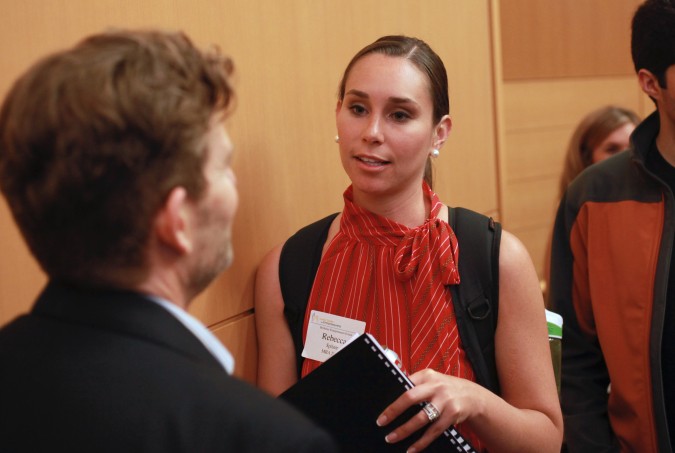
Moderator Sam Angus listens to student Rebecca Spitzer pitch her startup at the Berkeley Entrepreneurs Forum, August 30, 2012
Steve Bengston
PricewaterhouseCoopers
Steve Bengston heads the Emerging Company Services (ECS) group at PricewaterhouseCoopers. ECS acts as “mentor capitalists” for young, high potential companies.
Before joining PwC, Steve had 20 years of experience in a variety of marketing, business development and general management roles at several high tech companies in the Bay Area. Most recently, he was Pres/CEO of ynot.com [Note: not the website now online at that URL], a leading international emarketing and greeting card company. Previously, he was VP Marketing & Business Development at Worldview Systems, an Internet travel pioneer. At Worldview, Steve helped launch and market Travelocity with Sabre Interactive.
Steve has a BA in Economics and MBA from Stanford University. He works closely or sits on the Advisory Board at Churchill Club, SVASE, Life Science Angels, Bay Bio, and the Stanford/MIT Venture Lab, has taught classes on startups at UC Berkeley, San Jose State, Santa Clara Law School, Hastings Law School, and Stanford, and is active in a variety of other organizations in the Bay Area targeting entrepreneurs and investors. He is a frequent moderator/panelist at both university and industry sponsored events.
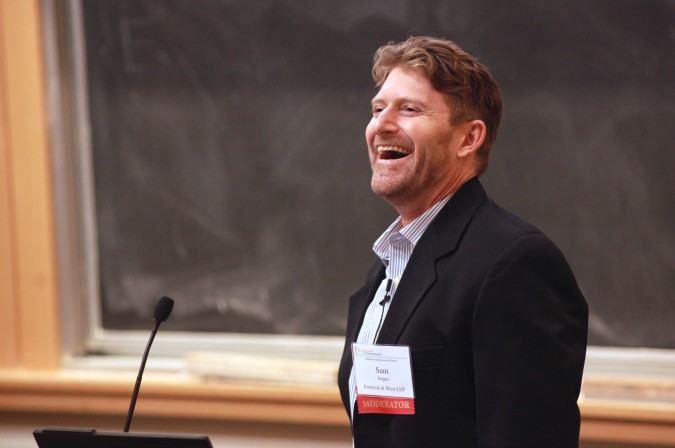
Sam Angus, a partner at law firm Fenwick & West LLP, moderates a panel at the Berkeley Entrepreneurs Forum, August 30, 2012
Jeff Clavier
Founder and Managing Partner
SoftTech VC
Based in Palo Alto, California, Jean-Francois “Jeff” Clavier is the Founder and Managing Partner of SoftTech VC, one of the most active seed stage investors in Web 2.0 startups. Since 2004, Jeff has invested 125 consumer internet startups (Fund I, Fund II, Fund III) in areas like social media, monetization, search, gaming or B2B/B2C web services. These investments are typically located in Silicon Valley, New-York and Boulder. With over 20 years of operational, entrepreneurial and venture capital experience, Jeff is able to add relevant perspective and value to his companies as they grow from inception to maturity, and hopefully, success.
Jeff was recognized as one of the 13 “Web 2.0 King Makers” by (late) Business 2.0. BusinessWeek named him one of “The 25 Most Influential People on the Web” in 2008, and one of the “Top 25 Angels in Tech” in 2010. He was also nominated in the “Best Angel” category at the Crunchies in 2009 and 2010. He is often noted for his investments in categories such as “passion-centric communities” or online gaming, or for having sold a number of his Web 2.0 startups to the likes of Yahoo, AOL, Intuit or more recently PayPal, Twitter and Groupon.
Some of Jeff’s representative investments include Mint (Intuit), Brightroll, Truveo (AOL), Userplane (AOL), Rapleaf, Ustream, Milo (eBay), Blekko, Eventbrite, Tapulous (Disney), DNANexus, FanBridge, BillFloat, Fab, Gigwalk, Byliner and Wildfire.
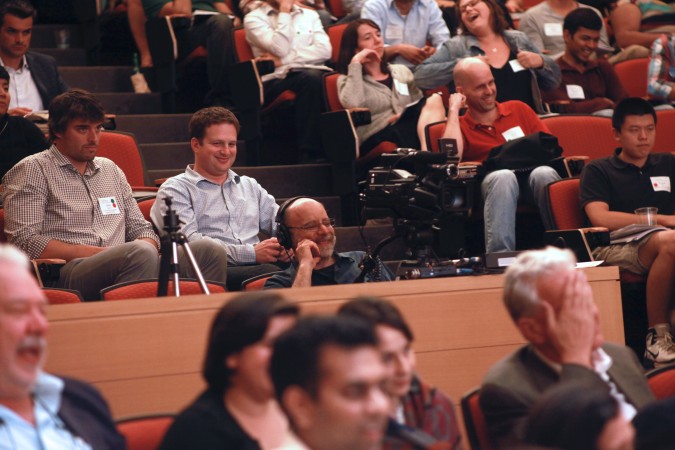
Stuart Sweetow, owner of Audio Video Consultants, capturing video at the Berkeley Entrepreneurs Forum, August 30, 2012
Vivek Mehra
August Capital
Vivek joined August Capital in 2003. He invests broadly in IT infrastructure and areas of interest include data center technologies, systems management, security, storage, and cloud computing systems and software. Prior to joining August Capital, Vivek co-founded Cobalt Networks in 1996. As CTO & VP of Product Development, Vivek built the first successful server appliance and grew Cobalt into a worldwide leader in the category, culminating in a successful IPO and acquisition by Sun Microsystems for $2B. At Sun, Vivek served as the Vice President and General Manager of the Cobalt Business Unit and a member of Sun’s Technical Architecture Council. Prior to founding Cobalt, Vivek held a number of technical and management positions at Apple, SGI, and Digital Equipment Corporation and successfully developed numerous products including Internet enabled set-top boxes, PDAs, RISC workstations, and high performance graphics subsystems.
Vivek received a BS in Electronics from Punjab University, India, and an MS in Computer Engineering from Iowa State University.
To my knowledge, I have been attending The Berkeley Entrepreneurs Forum for longer than anyone else besides Jerry Engel, who founded The Lester Center in 1991 and was its Executive Director for nearly two decades.
I have some suggestions to improve the The Entrepreneurs Forum, which I will describe here. I am posting these suggestions publicly because they are likely applicable to numerous programs across the globe, and I’d like to see these ideas adopted widely if people think they are worthwhile.
1. Dispense with the table panelists sit at. The table doesn’t look good on camera or video, and over time the majority audience for the Forum should be watching online, since the rooms frequently sell out already. Panelists should sit on arm chairs or couches, like they do at most tech conferences that I attend. The moderator should sit with the panelists and not be off to the side standing at a podium. All the people on stage should be outfitted with wireless lapel microphones. I would like the Forum to appear more conversational in style. The table separates the speakers from the audience, where arm chairs suggest a residence for a more intimate vibe.
Here’s an example of a more visually appealing way to run a panel. Steve Bengston is the moderator for this panel at The Churchill Club, where he is a member of its Board of Directors and its past Chair.
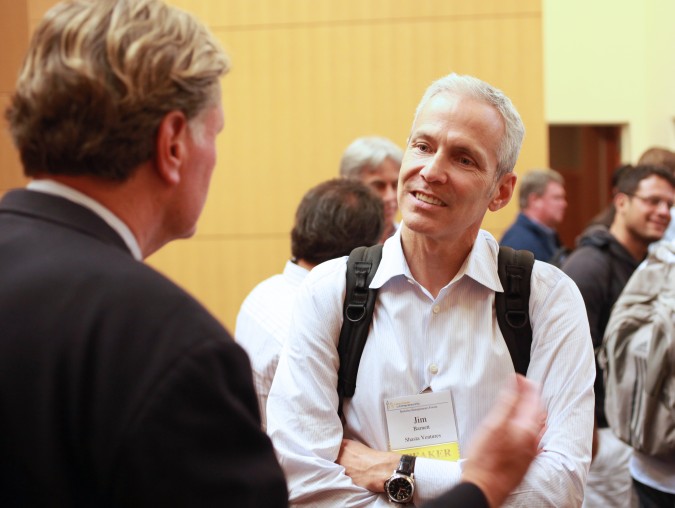
Jeff Burton, the brand new Executive Director of the UC Berkeley Skydeck, talks with Jim Barnett of Shasta Ventures, August 30, 2012
2. Commercial bottled water should be forbidden on stage, even if the speakers bring it with them. Nearly all the conferences I attend serve water from pitchers into real glasses. Bottled water is an evil product, and it looks bad in photographs and video to see those bottles. Image is important, and promoting bottled water by showing it on stage should stop.
3. Commercial bottled water should not be a beverage choice during the networking hour. Tap water should be offered, and it should not require a drink ticket.
4. When it comes time for audience questions, invite the questioner to sit on stage in an arm chair or on the couch while they ask the question and while they are receiving the answer. This will give the questioner time on video, and will permit them to look the speakers in the eye. This will be a treat for the audience members, because they’ll feel they get to ‘meet’ the panelists for 60 or 120 seconds. Questioners can line up to get their turn on stage. Questioners should be encouraged to state their first and last name, so they can be identified online.
5. Although I appreciate that it’s a lot of work, the Forums should be transcribed, and the transcribed text should be posted online. This is a certain way to get more traffic to The Lester Center website, and it’s likely to increase the interest in the Forum from attendees that can’t attend in person.
6. All Forums should be archived online, including Forums from ten and twenty years ago. Forums should never expire and be removed.
7. The ‘numbers’ should be videotaped and included in the online video. The numbers are often the most interesting part of the evening. The contact information for the number presenters should be posted online, with permission of course, and there should be a hyperlink to the project the person is working on.
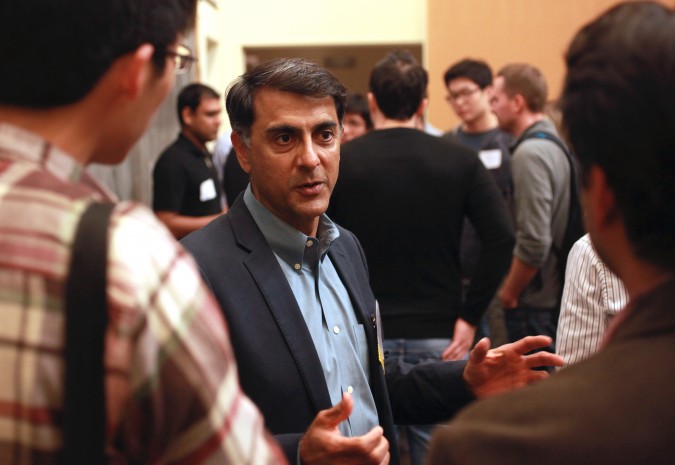
Vivek Mehra, a partner at August Capital, answers questions posed by attendees at the Berkeley Entrepreneurs Forum, August 30, 2012
8. The photographs taken by Bruce Cook, the official photographer, should be publicly posted to Facebook, and should be tagged. Once the identities of the people pictured are known via the tagging, the captions for the official Lester Center website should be updated to identify everyone whose name is known. If required, change the terms of the tickets purchased to give UC Berkeley the right to identify the people by name. Offer an ‘opt out’ list during checkin. Having the names with the pictures will increase traffic to The Lester Center website, since people will search for those names for decades to come. Invite people to tag the pictures in the emails The Lester Center sends out and via Facebook status updates.
9. A vast collection of at least 5,000 of Bruce Cook’s unpublished photographs of the Forum from the last twenty years should be published to Facebook and the Web, and they should be tagged and captioned. This was entirely my idea — Cook did not hint that I propose such an idea. The majority of the pictures published should be of the networking hour, to get as many people from the audiences over the years tagged as possible.
10. The Forum should be oversold, like airplane seats. This August 30th Forum was ‘sold out’ but there were unfilled seats in the auditorium, which takes away from the excitement of a sold out show. If too many people show up, they can watch on video monitors in the Bank of America Forum, and as compensation for not getting a seat, their entrance fee can be 100% refunded. I predict the revenue over time from overbooking will more than make up for the refunds that need to be given. Attendees should be told when they buy their tickets they risk being bumped, and encouraged to arrive early to be sure they get a seat.
11. The reminder to ‘Like’ The Lester Center on Facebook should be repeated on a poster displayed during the Forum. The Forum’s Twitter handle should also be on this poster.
12. Attendees should be given a perk if they follow the Forum on social networks, such as a second drink ticket on their next visit to the Forum, to encourage getting as many followers as possible. Currently attendees may eat unlimited quantities of food at the Forum, but are permitted only one drink, either with alcohol or without.
13. Attendees should be invited to blog and post about the Forums, and The Lester Center site should find and link to the best examples of such efforts, to encourage people to write about the Forum.
I am one of the only bloggers writing about the Forum, but there should be at least several.
14. I love the luxurious food served during the networking hour, but it sure seems like it must cost a fortune. I think it would be more than fine to switch to less fancy food. There is precedent for this. Last year at the Founder School Demo Day what appeared to be inexpensive sandwiches were served, but the event was superb and not diminished by the more everyday food. I suspect the food budget for the Forum could be cut by two thirds without getting more than a handful of complaints. The Forum is still too expensive at USD $25 a ticket, and I bet it loses money even at that price. When I started attending in my mid twenties, the cost was prohibitive. It was only due to my getting free tickets from my employer at the time, Cooley, that I attended regularly. The goal should be to get lots of currently poor entrepreneurs in the making to attend, including but not limited to Berkeley students.
I suggest the price should be no more than $10. To get the price that low, I suggest alcohol should cost extra.
That is all my suggestions for now. The Forum is already a success, or I would not have attended for twenty years. I am trying to make the Forum better.
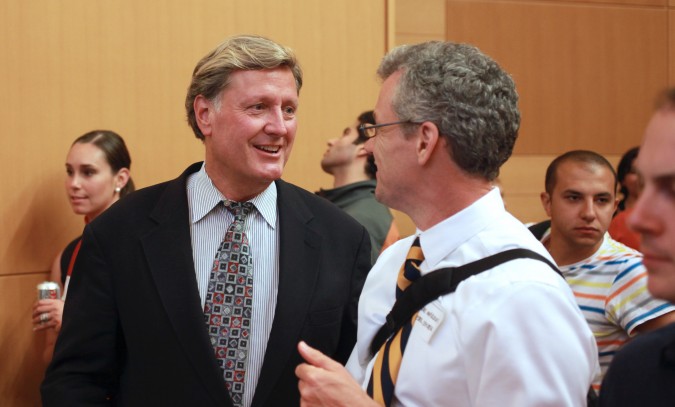
Jeff-Burton, left, the brand new Executive Director of the UC Berkeley Skydeck talks with Andre Marquis, Executive Director of The Lester Center for Entrepreneurship & Innovation, August 30, 2012. Photo by Kevin Warnock.
I upload pictures to this blog at the maximum resolution my camera produces — 21 megapixels. Click on them twice in delayed succession to see them at full size. I shot these pictures at ISO 4,000 due to the low lighting levels.
Click here to see all the posts I have written about the Berkeley Entrepreneurs Forum.
The law firm Fenwick & West LLP where Sam Angus is a partner produced and gave away a great 80 page booklet at the Forum. Retired Fenwick attorney Jacqueline Daunt wrote a fantastic introduction to startups that includes a capitalization table for a hypothetical company from pre-funding stage through a public stock offering. Thank you Fenwick! If I can post this booklet, please let me know and I’ll update this post with a link to a PDF scan of the booklet.
Finally, as an end note, I met Steve Bengston in 1999 during the first dot com boom, when he agreed to help me with Hotpaper, my startup at the time. It turned out I didn’t call on him much, since I lined up financing almost too easily, but I will never forget pitching him at his PriceWaterhouseCoopers office in San Jose, California USA, and him telling me at that meeting that he would help me. Bengston is well known, and I was thrilled to have his support, especially back then when I didn’t know many people or know much of anything.
Why in 1978 I moved to San Francisco from Chicago
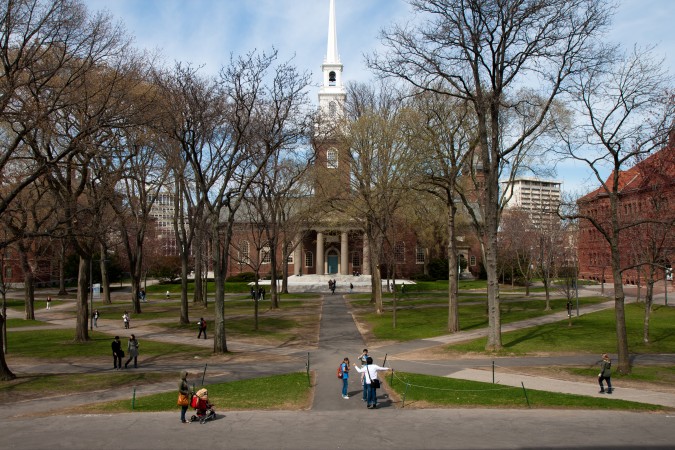
The Memorial Church at Harvard University photographed by Flickr.com user Siim Teller, April 22, 2011
Tonight, September 2, 2012, I learned why in 1978 I moved to San Francisco, California USA. I never knew why until today, because I never thought to ask the right questions.
I was born in Chicago, Illinois, USA, at the University of Chicago, where my mother worked as a Pathologist.
My parents had married soon after she graduated from Harvard Medical School, where she was one of five women in a class with 145 men.
My mother met my father Robert Warnock at Harvard, where he earned his PhD in Physics.
My father and my mother got married in The Memorial Church on the Harvard University campus, a church I visited in 2000 when I was in Boston, Massachusetts, USA meeting with storage vendor EMC to discuss an investment by their venture capital division in my startup Hotpaper.
When I visited The Memorial Church, it was just another church. When I told my father about my tour of the Harvard campus, courtesy of my EMC provided limousine with two eager salesman trying to sell me an unnecessary USD $1,000,000 dollar storage array for my startup, my father said ‘your mother and I got married in that church!’
After they wed, my father decided to move with my mother to Chicago so that he could work at the Illinois Institute of Technology (IIT).
My mother was doing research at the University of Chicago, discovering that asbestos is even deadlier than was known at the time. Amazingly, the University of Chicago did not have a spectroscopy attachment for its electron microscope, and my mother needed this device for her research. IIT did have the needed equipment, but they charged money to use it, and IIT was a lengthy drive from our house at 5138 South Dorchester in Hyde Park, on the South side of Chicago. My mother rode her bicycle to University of Chicago, and it would have not have appealed to her to have had to drive to IIT on a frequent and regular basis.
My mother’s research was funded by the National Institutes of Health. I would think that a grant could have been won to order a spectroscopy attachment, but for whatever reason, that was not the path my mother took. Instead, she wrote to a friend she had worked with for a year some twenty years earlier in Seattle, Washington, USA. During that two decade span, that friend had become Chair of the Pathology Department at the University of California at San Francisco.
My mother explained her research and that she had heard that UCSF had a spectroscopy attachment for its electron microscope. My mother asked her friend if she could move to San Francisco and work at UCSF so she could use the required hardware. Her friend said ‘yes,’ and my mother started at UCSF as a full professor.
I learned tonight that my mother was promoted to full professor at University of Chicago just one month before she left for San Francisco. She had been an Associate Professor before that, and I remember as a kid the day my mother was granted tenure. Since I was young, I hadn’t heard that word before, so I thought she said ‘ten year.’ I assumed it was her tenth anniversary of employment. I told my mother that story tonight — perhaps for the first time.
I have a suspicion that University of Chicago panicked when they found out she was leaving for UCSF and rushed through the promotion to full professor, because the timing is so unlikely to have happened naturally. Even if that’s the case, I am sure my mother was pleased that she got to be a full professor at University of Chicago and University of California at San Francisco. My mother retired from UCSF years ago, so is now Professor Emeritus. She still has a website on the UCSF web server.
My mother decided to move our family to San Francisco, since my father had made the decision to move to Chicago. I did not know this until today.
I had always thought we moved to San Francisco because of its reputation as a great cosmopolitan city with superb weather. I had sometimes considered that perhaps UCSF had recruited my mother, but she dispelled that notion today. She did not have to interview for the job at UCSF. She did not have to compete with dozens of candidates. She asked her friend if she could work at UCSF and he said ‘yes.’
I am so thankful my mother needed a piece of equipment that University of Chicago didn’t have. She moved us to the center of the Internet world, and had we stayed in Chicago, I probably would not have become an Internet entrepreneur, which has allowed me to build a richly rewarding life that I cherish.
Thanks Mom! I love you.
